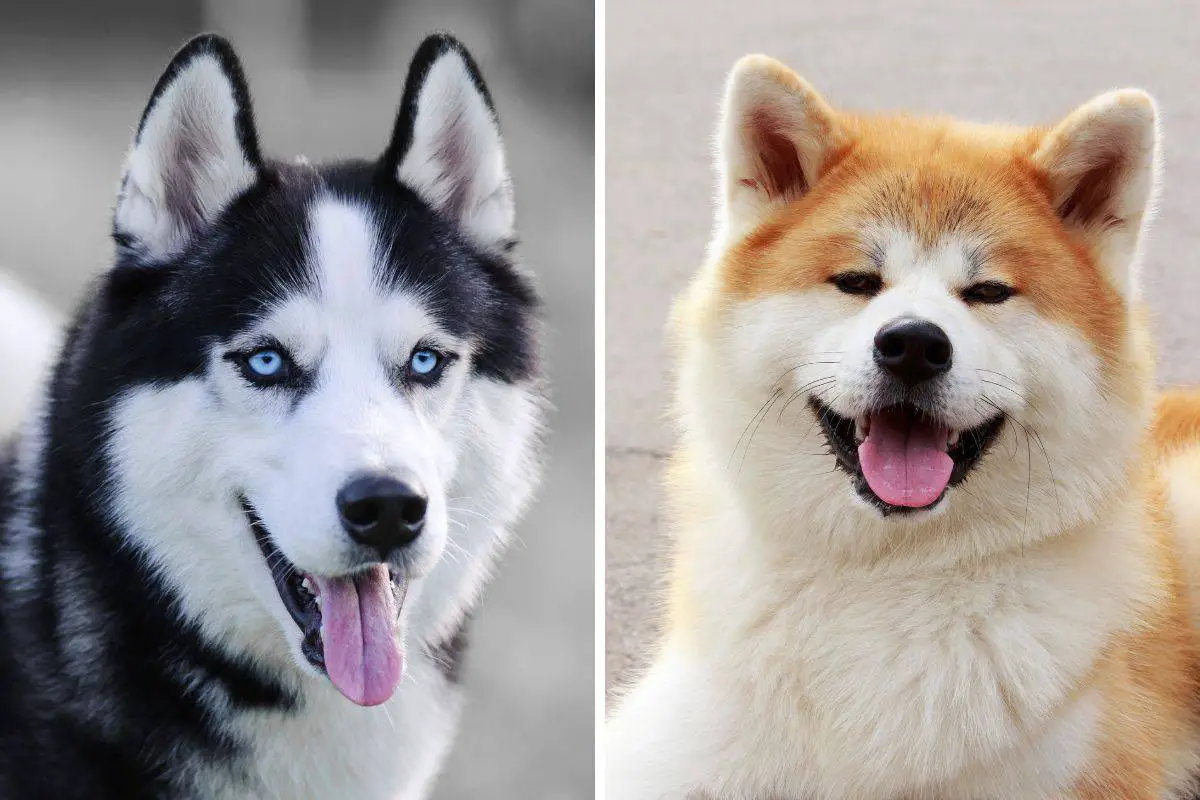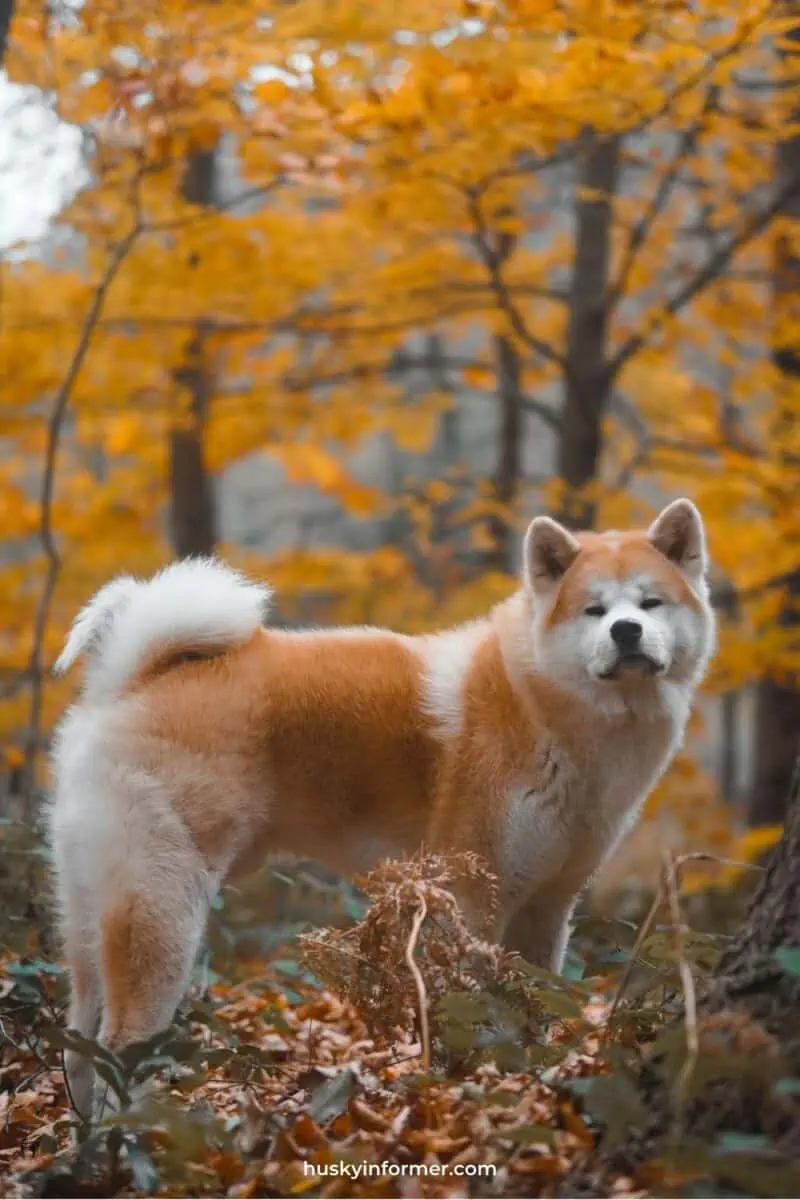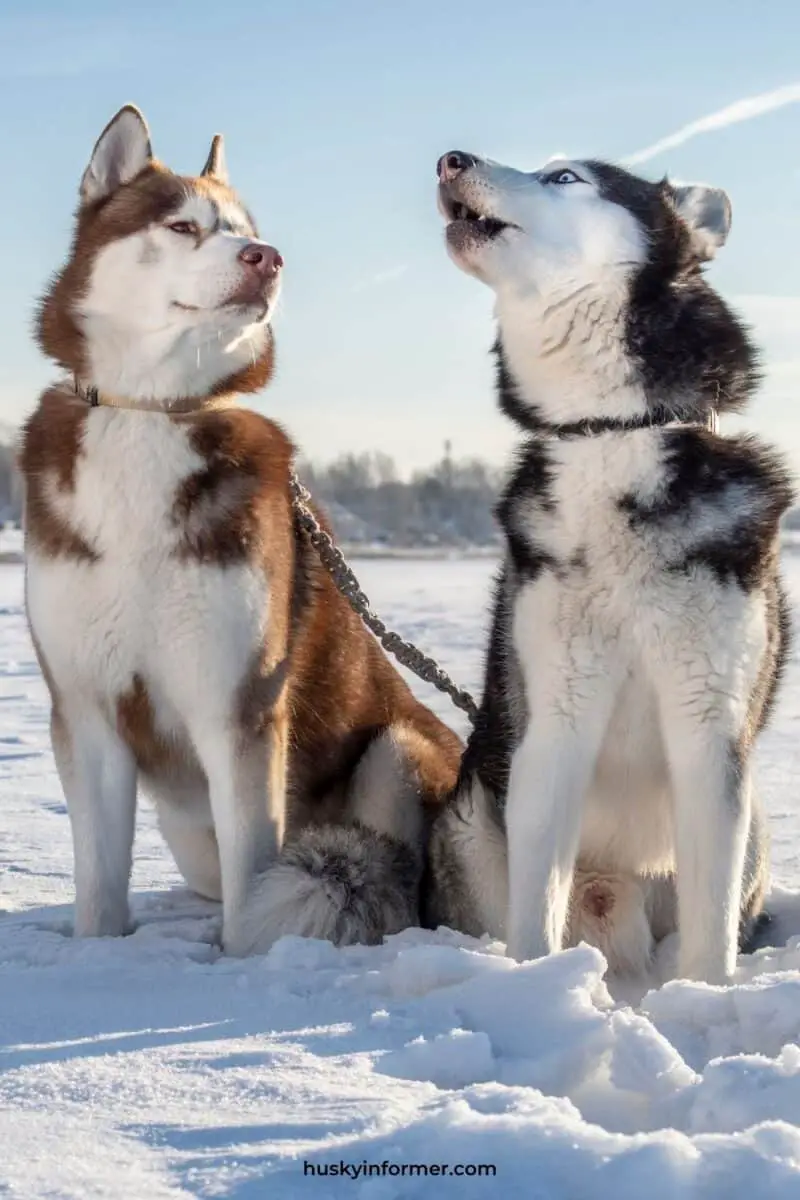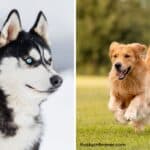When it comes to choosing between a Siberian Husky and an Akita, it’s like deciding between two majestic forces of nature. Both breeds boast unique traits and storied histories, making them fascinating companions for the right owners. I’ve always been intrigued by their distinct personalities and physical characteristics, which set them apart in the dog world.
Akitas, with their bear-like faces and sturdy build, exude a sense of calm strength, while Siberian Huskies, known for their striking eyes and fox-like expressions, radiate energy and playfulness. Each breed brings its own set of challenges and rewards, and choosing between them is more than just a matter of preference.
Let’s dive into what makes each breed so special and see if we can’t help you decide which might be the right fit for your lifestyle.
Article content:

Appearance
When I’m considering the unique beauty of dog breeds, the Siberian Husky and Akita stand out for their striking appearances.
Both breeds possess a natural elegance and a presence that commands attention. Though they share a few similarities, such as their thick double coats, their aesthetic differences are quite pronounced, catering to different preferences among dog lovers.
Siberian Husky Appearance
The Siberian Husky is often admired for its graceful, athletic build and distinctive fur patterns. One can’t help but notice their medium-sized frame, which balances strength with agility, perfectly reflecting their heritage as enduring sled dogs.
Their fur, a dense double coat, offers incredible protection against cold temperatures, a necessity for their original roles in the harsh climates of Siberia. The coat of a Husky can come in a variety of colors, from pure white to black, and many shades in between, often combined with striking markings that are unique to each dog.
Beyond their fur, it’s their eyes that truly captivate. Huskies might have blue, brown, or even one eye of each color—a condition known as heterochromia—that adds to their enchanting appearance. Coupled with their pointed ears and friendly, expressive faces, Siberian Huskies carry an allure that’s hard to resist.
Akita Appearance
In contrast, the Akita presents a more robust and imposing figure, embodying power and nobility. Originating from Japan, this breed typically showcases a larger build with males standing between 26 to 28 inches tall at the shoulder, significantly taller than their Husky counterparts. They possess a broad head with a short muzzle, small eyes, and erect, triangular ears, projecting a dignified expression.
Their double coat is similarly designed for harsh weather, but the Akita’s fur tends to be even thicker and more luxurious, requiring regular grooming to maintain its condition. The fur color range is extensive, including pure white, brindle, and pinto, allowing for a splendid variety within the breed. The Akita’s tail is another distinctive feature, curling over its back in a fluffy, graceful sweep that adds to its majestic appearance.
Both the Siberian Husky and Akita boast impressive double coats, a signature characteristic that not only serves a functional purpose but also enhances their magnificent presence. While their appearances cater to different aesthetic preferences, it’s clear that both breeds carry a unique charm and beauty, making them beloved companions for those who appreciate their distinct looks.
Temperament
When delving into the world of canine companions, understanding the temperament of each breed is crucial for potential pet owners. The Siberian Husky and the Akita offer intriguingly diverse personalities that cater to different preferences and lifestyles. Here, I’ll break down the temperament of each breed to shed some light on what future pet owners can expect.
Siberian Husky Temperament
The Siberian Husky is known for its mischievous, loyal, and loving nature. Being part of my family means observing firsthand their high-energy antics and their need to be the center of attention. Huskies possess an innate fondness for companionship—not just with humans but with other dogs too. Their outgoing and friendly demeanor makes them excellent family dogs, especially in homes with children.
One cannot discuss Huskies without mentioning their vocal tendencies. Unlike many breeds that bark, Huskies are renowned for their howling. This trait, along with their independence and stubborn streak, can present challenges in training. Yet, with consistency and positive reinforcement, I’ve found these intelligent dogs are capable of learning a wide range of commands and tricks. Their double coat, a majestic fur, requires regular grooming to manage shedding, especially during seasonal changes.
Akita Temperament
In contrast, the Akita presents a more dignified and reserved temperament. This breed carries a noble bearing, with a loyalty and courage that are unmatched. Akitas form deep bonds with their family members, often becoming particularly attached to one person. They’re known for their protective nature, serving as vigilant guardians of their home without the need for constant barking. The Akita’s silence is a sign of their watchfulness, making them the silent observers in the canine world.

Despite their guard dog instincts, Akitas exhibit a calm and affectionate side with those they trust. They require a confident owner who can establish and maintain leadership, as Akitas respect authority and thrive in a structured environment. Their thick double coat lends them a majestic appearance but also calls for regular grooming to manage shedding.
Training an Akita demands patience and consistency due to their independent nature. I’ve learned that positive reinforcement and early socialization are key factors in nurturing a well-behaved Akita. These dogs excel in environments where they can exercise not only their bodies but their minds, highlighting the importance of offering mental stimulation to keep them engaged.
Exercise and Activity Level
In the fascinating world of dog breeds, understanding the exercise and activity level requirements of each breed is crucial for ensuring a happy, healthy pet. I’ll delve into the specifics of two majestic breeds: the Siberian Husky and the Akita. Their distinctive needs are not just a reflection of their physical attributes but also a substantial part of their well-being.
Siberian Husky Exercise and Activity Level
The Siberian Husky is a breed that screams energy and vivacity. Known for their endurance and zest for life, Huskies require a substantial amount of exercise on a daily basis. I’ve observed that they are not merely content with leisurely walks. Instead, they thrive on vigorous activities like running, hiking, and even pulling activities that pay homage to their sled-pulling ancestry.
A Minimum of 60 Minutes of intense exercise a day is essential for a husky to remain fit and content. This might include:
- Long runs
- Hiking on trails
- Playing fetch or tug-of-war
Huskies possess a double coat that offers protection against extreme temperatures, making them capable of enjoying outdoor activities, even in colder weather. However, it’s vital to ensure they’re properly hydrated and not overexerted during warmer seasons. Their thick fur can make them more prone to overheating.
Husky owners should also incorporate mental stimulation into their exercise routines due to the husky’s intelligent and sometimes mischievous nature. Agility training or search games can be excellent ways to keep their minds as active as their bodies.
Akita Exercise and Activity Level
Moving on to the Akita, this breed presents a slightly different set of exercise needs. Despite their size and imposing appearance, Akitas possess a moderate energy level. They require consistent, but not overly vigorous, physical activity to stay in shape and maintain their mental health.
For an Akita, a Daily Exercise Routine of about 30 to 45 minutes is generally sufficient. This could include:
- Brisk walking
- Gentle hiking
- Playtime in a securely fenced yard
Akitas also have a double coat, similar to the Husky, which aids in temperature regulation. This characteristic makes them somewhat adaptable to various weather conditions for outdoor activities. However, due to their thick fur, it’s important to be cautious and prevent overheating, especially in the summer months.
One characteristic I’ve noticed with Akitas is their intelligence coupled with a dignified reserve. This makes them more inclined towards exercises that involve some mental engagement but don’t necessarily require the high-impact, high-intensity activities that a Husky would crave.
Grooming and Maintenance
Taking care of a dog isn’t just about providing love, shelter, and food. It also involves regular grooming to ensure their fur remains in top condition, particularly for breeds like the Siberian Husky and Akita, both of which have double coats that require attention. Here, I’ll dive into the specifics of grooming and maintaining the coats of these beautiful dogs.
Siberian Husky Grooming and Maintenance
Siberian Huskies are renowned for their stunning double coat that consists of a dense undercoat and a longer topcoat. This dual-layered fur serves as insulation against both cold and heat but entails a significant grooming responsibility. Siberian Huskies shed throughout the year, and during the spring and fall, they experience heavy shedding periods, also known as “blowing” their coat. During these times, daily brushing becomes essential to manage the shedding and help keep their coat healthy.
For most of the year, a weekly brushing session is sufficient. However, during their shedding seasons, I recommend upping the frequency to daily grooming to keep the fur from accumulating everywhere in your home. A de-shedding tool or a metal rake is perfect for this job, as it reaches through the topcoat to remove loose fur from the dense undercoat.
Despite their propensity to shed, Huskies are relatively clean dogs with little to no “doggy odor” and they don’t require frequent baths. Bathing them every three to four months or only when they get dirty is often enough. Overbathing can strip their coat of natural oils, leading to skin irritation.
Make sure to also use husky appropriate shampoos when grooming your pup.
Akita Grooming and Maintenance
Akitas also boast a luxurious double coat, with a dense undercoat that sheds heavily twice a year. Similar to Huskies, Akitas require regular grooming to maintain their coat’s health and manage shedding. However, their grooming needs might be a bit more demanding due to the texture and volume of their fur.
Weekly brushing is a must for Akitas to keep their coat shiny and reduce shedding. When they are blowing their coat, which typically happens in the spring and fall, more frequent grooming is necessary to control the amount of fur they shed. A solid undercoat rake and a slicker brush are essential tools for Akita owners, helping to untangle fur without causing discomfort.
Bathing an Akita should be done sparingly, only about every three months or so, unless they’ve rolled in something unpleasant. Their thick coat takes time to dry, and it’s crucial to ensure they’re thoroughly dried to prevent any skin issues. After a bath, a blow dryer on a cool setting can help fluff their coat and remove any loose fur.
Health
When considering bringing a furry companion into your life, it’s crucial to understand their potential health needs. In this section, I’ll dive deep into the health aspects of the Siberian Husky and the Akita, two breeds known for their stunning looks and unique personalities. Both breeds may share a double coat and an impressive presence, but when it comes to health, they have their distinct challenges.
Siberian Husky Health
The Siberian Husky, with its thick double coat and wolf-like appearance, is not just a bundle of energy but also generally a picture of health. However, like any breed, they do have their share of health concerns. The most common issue among Huskies is eye conditions, affecting about 10% of the breed. Cataracts are at the top of this list, alongside progressive retinal atrophy and corneal dystrophy. While these conditions don’t occur frequently, they can lead to serious implications if not addressed early.
| Condition | Prevalence in Huskies |
|---|---|
| Cataracts | High |
| Hip Dysplasia | Moderate |
| Progressive Retinal Atrophy | Less Common |
Another point of concern is hip dysplasia, a genetic condition that tends to develop within the first two years of a Husky’s life. It’s important to note that while huskies are susceptible, they’re among the less affected breeds. Strenuous exercise can exacerbate this condition, so moderation and proper care are key.
The Siberian Husky’s double coat doesn’t just add to their aesthetic appeal; it also serves as a natural insulator against cold temperatures. However, it requires regular grooming to maintain its health and sheen, which indirectly contributes to their overall well-being.
Akita Health
Turning our attention to the Akita, this breed’s imposing stature is matched by a strong personality and, unfortunately, a predisposition to certain health issues. Hip Dysplasia also affects Akitas, similar to Huskies, but they face additional concerns like acquired myasthenia gravis, von Willebrand disease, and various immune diseases affecting the skin.
| Condition | Prevalence in Akitas |
|---|---|
| Hip Dysplasia | High |
| Myasthenia Gravis | Moderate |
| Von Willebrand Disease | Less Common |
Of particular note is their double coat, which, like the Siberian Husky, requires regular care to prevent matting and skin issues. The Akita’s fur plays a significant role in its health, providing not just insulation but also protection against skin problems.
Size and Weight
When considering a new furry addition to your family, understanding the size and weight differences between breeds is crucial. Today, I’m diving into the specifics of two stunning breeds: the Siberian Husky and the Akita. Both renowned for their double coats and adaptability to cold climates, these breeds have distinct physical attributes that set them apart. Let’s delve into what makes each breed unique in terms of size and weight.
Siberian Husky Size and Weight
When I first laid eyes on a Siberian Husky, I was taken aback by their athletic build and striking appearance. Known for their endurance and designed for long-distance running, Huskies have a relatively modest size. Male Siberian Huskies typically weigh between 35 to 60 pounds (16 to 27 kg) and stand about 21 to 23.5 inches (53 to 60 cm) tall at the shoulder. Females are usually on the lighter end of this scale. This manageable size makes them excellent companions for those with an active lifestyle but perhaps not as much space at home.
Their thick double coat not only adds to their majestic appearance but also provides the necessary insulation to thrive in cold environments. This fur requires regular maintenance to keep them looking their best and to manage shedding, especially during the warmer months.
Akita Size and Weight
On the other hand, the Akita presents a more imposing figure. These dogs are undeniably robust and powerful, traits that were essential for their original role as hunters in Japan. Male American Akitas can tip the scales at 100 to 130 pounds (45 to 58 kg) and stand 26 to 28 inches (66 to 71 cm) tall. This considerable size advantage over Huskies can be attributed to their stocky build and dense muscle mass, which supports their capabilities as both protectors and hunters.
Their double coat is no less impressive, providing insulation and allowing Akitas to excel in cold environments much like the Huskies. However, the sheer volume and density of an Akita’s fur mean that grooming habits must be meticulously adhered to prevent matting and maintain skin health.
In comparing the Siberian Husky and the Akita, it’s clear that their traits in size and weight are as distinct as their personalities. While Huskies offer agility and moderate dimensions, Akitas bring formidable size and strength. Prospective owners should weigh these factors carefully against their lifestyle and preferences before making a decision. Whether it’s the graceful Husky or the steadfast Akita, both breeds carry a rich heritage and an array of qualities that make them cherished companions.
Training and Intelligence
When comparing the Siberian Husky and Akita, two popular and visually striking breeds, it’s crucial to understand their training demands and intelligence levels. Both breeds possess unique challenges and strengths in training, rooted in their history and personality traits.
Siberian Husky Training and Intelligence
Siberian Huskies are renowned for their intelligence and independence. Training a Husky can be a test of wills, as they possess a strong desire for autonomy. They’re not particularly driven to please their owners, which is a stark contrast to breeds like the German Shepherd. This characteristic makes training a Husky more about mutual respect and understanding than dominance.
Incorporating positive reinforcement techniques and maintaining consistency are key to training a Siberian Husky. Their intelligence means they learn commands quickly but might choose to ignore them if they see no reason to comply. Despite their stubborn streak, Huskies are mischievous and playful, qualities that can be channeled into training sessions that are both engaging and fun.
The double coat of the Siberian Husky isn’t just a hallmark of their appearance but also an indication of their working dog heritage. This dense fur requires regular grooming but also served a practical purpose, offering insulation in harsh climates where Huskies were expected to work closely with humans. This aspect of their care is crucial to understand, as it reflects the breed’s need for active engagement and mental stimulation.
Akita Training and Intelligence
Akitas, with their imposing stature and powerful build, bring a different set of challenges to training. Known for their loyalty and protective instincts, Akitas possess a deep intelligence that manifests in a reserved and often independent demeanor. They are not as openly communicative as Huskies, making their training more about building trust and authority.
Training an Akita requires a consistent, firm approach coupled with positive reinforcement. Their loyalty means once you’ve established that trust, they are more inclined to follow commands a bit more readily than Huskies. Early socialization and obedience training are essential for Akitas, as their protective nature can lead to aggression if not properly managed.
Similar to Huskies, Akitas also sport a double coat, which requires regular grooming to maintain their health and appearance. This aspect of their care can also be an opportunity to strengthen the bond between Akita and owner, laying a foundation of trust that’s crucial for effective training.
In training both Siberian Huskies and Akitas, patience and consistency are paramount. While their intelligence isn’t in doubt, their willfulness and independent nature pose unique challenges. Understanding these traits and how they translate into training requirements is essential for any potential owner. These breeds are not just pets but partners, requiring a commitment to understand and meet their needs for a harmonious relationship.
Interaction with Other Pets and People
When considering bringing a new furry friend into your home, understanding how they’ll interact with other pets and people is crucial. Both the Siberian Husky and the Akita have unique traits that define their interactions, shaped by their history and breed characteristics.
Siberian Husky Interaction with Other Pets and People
I’ve observed that the Siberian Husky, with its sociable and friendly nature, often makes an excellent companion for both humans and other animals. Huskies are pack animals, and this trait translates into a desire for company, be it human or animal. Their friendly demeanor means they usually get along well with children and can be very playful. However, their high energy levels and strong prey drive might be overwhelming for smaller pets like cats, unless they’ve been raised together or the Husky has been well-trained.

Given their double coat, Huskies are quite adaptable to various climates, making outdoor social activities a year-round possibility. This adaptability extends to social settings where their fur, albeit beautiful and plush, requires regular grooming to prevent shedding from becoming a nuisance. The engagement in grooming can also become a bonding activity, strengthening the connection between Huskies and their owners.
Akita Interaction with Other Pets and People
The interaction of an Akita with other pets and people can be quite different from that of a Husky. Akitas are known for their loyalty and affection towards their family, often forming a strong bond with one person in particular. They can be aloof and reserved around strangers, reflecting their history as guard dogs in Japan. This protective nature does mean that Akitas require early socialization to ensure they understand how to behave around other pets and people.
When it comes to other animals, Akitas might not be as welcoming as Huskies. Their strong prey drive and tendency to be dominant can lead to aggressive behavior if not properly managed. However, with the right training and socialization from a young age, Akitas can learn to coexist peacefully with other pets. Like Huskies, Akitas also have a double coat that requires regular grooming to manage shedding. This shared need for maintenance can help in building a routine and establishing a calm, authoritative relationship between the Akita and their owner.
While both breeds exhibit some similarities in their interactions due to their double-coated fur, their inherent natures dictate different approaches when it comes to forging relationships with other pets and people. Understanding these traits and adjusting the environment and training accordingly can pave the way for a harmonious living situation.
Who Should Get a Husky?
Deciding to bring a Siberian Husky into your life isn’t a decision to be made lightly. I’ve discovered through my experience that not all households are suited for a Husky’s vibrant energy and demanding nature.
Given their double coat, Huskies are built for colder climates (even though huskies can live warmer climates like Texas), making them an excellent choice for individuals living in cooler environments. Their thick fur not only provides insulation against the cold but requires regular grooming to maintain their health and appearance. Therefore, potential Husky owners should be prepared for a considerable amount of shedding, especially during their shedding seasons.
The Siberian Husky’s boundless energy and strong hunting drive make them ideal for active individuals or families who love the outdoors and can provide plenty of space for them to exercise. I’ve learned that Huskies thrive in environments where they can run, play, and explore, making a home with a large, secure backyard an optimal setting. Their high escape potential means that a secure fence, one that they cannot easily jump over or dig under, is essential for keeping them safe.
Huskies are also incredibly sociable, enjoying the company of both humans and other pets. This makes them a fantastic addition to families with existing pets, provided they’ve been properly socialized. However, due to their strong prey drive, supervision around smaller animals is advisable.
In terms of personality, if you’re looking for a quiet companion, a Husky might not be the best fit. Their love for barking and howling is well-documented, and while some may find this endearing, it could pose a challenge for those seeking a more serene home environment.
In a nutshell, if you’re someone who loves outdoor activities, doesn’t mind a bit of fur around the house, and is capable of providing a secure and loving environment, a Husky could be the perfect addition to your life. Their loyalty, friendliness, and striking appearance make them not just pets, but true members of the family.
Who Should Get An Akita?
Deciding to bring an Akita into your life isn’t a spur-of-the-moment decision. With their double coats and impressive size, Akitas are both visually striking and demanding pets. From my experience and extensive research, here’s who I think should consider getting an Akita.
First, it’s essential to understand that Akitas have a loyal and protective nature, making them excellent companions for those seeking a devoted family member. Unlike the Siberian Husky, which thrives in social situations with high energy, Akitas offer a more reserved demeanor, showing affection predominantly towards their family. This breed is suitable for individuals or families looking for a dog that is less demanding in terms of social interaction but still offers companionship and protection.
A key consideration is the size and strength of the Akita. Their robust build necessitates a confident and authoritative handler who can ensure the Akita knows who the leader is. They’re not the breed for first-time dog owners or those unfamiliar with handling large breeds. With males reaching up to 120 lbs, potential owners need to ensure they can physically manage a dog of this size.
The Akita’s double coat also means they require regular grooming to manage shedding and maintain their coat’s health. While this might be a deterrent for some, it’s a labor of love for those who don’t mind the grooming commitment. This trait also makes them well-suited to cooler climates, but it’s important to address their need for a comfortable and cool environment during hotter seasons.
Considering their dietary needs, Akitas eat more than many other breeds but maintaining a balanced diet will prevent weight gain and ensure their health. I always ensure my Akita gets high-quality kibble tailored for large breeds, giving them all the nutrients they need without overfeeding.
Ultimately, adding an Akita to my home has been incredibly rewarding. They’ve brought a sense of security, companionship, and unconditional love. For those who have the space, time, and willingness to meet their needs, an Akita can be a wonderful addition to your life.


